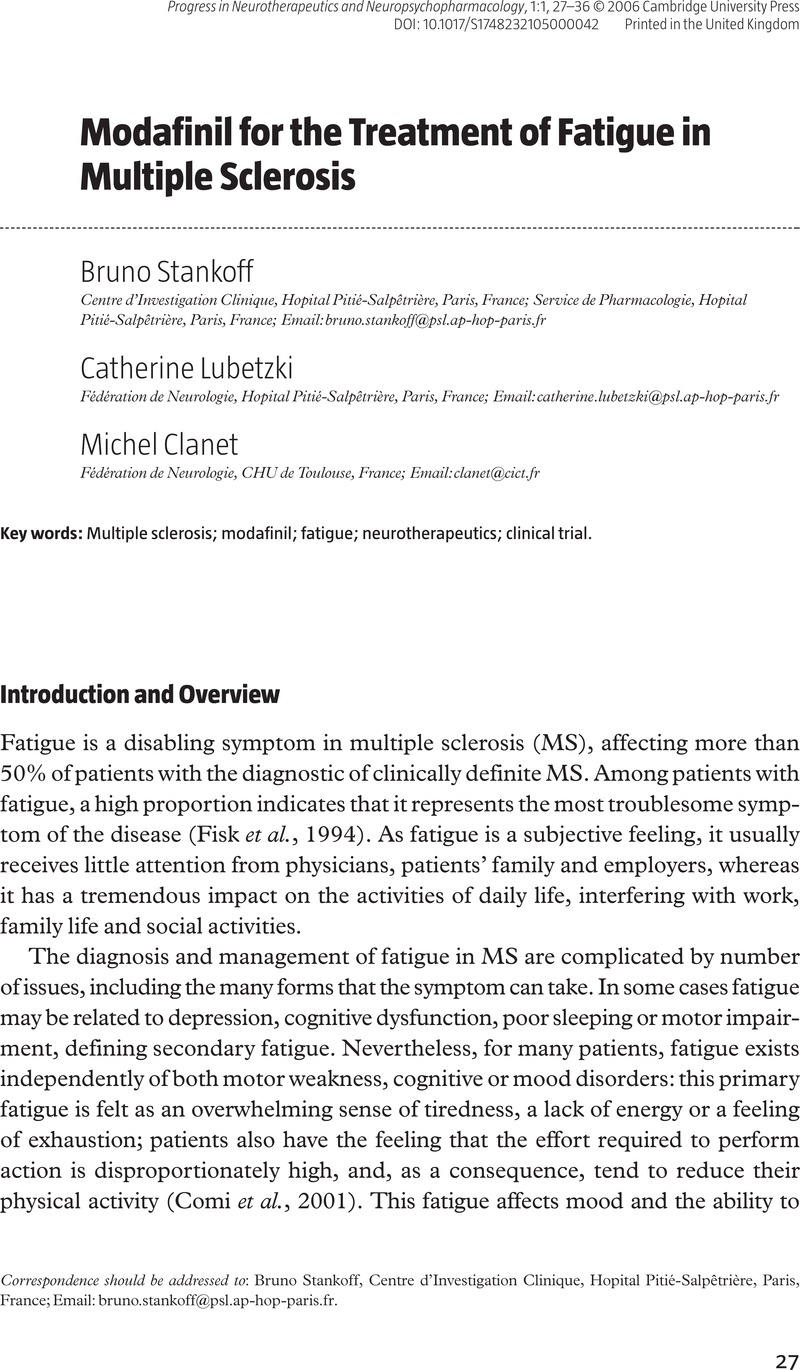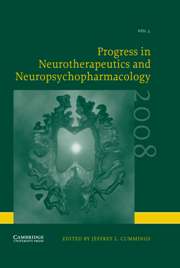No CrossRef data available.
Article contents
Modafinil for the Treatment of Fatigue in Multiple Sclerosis
Published online by Cambridge University Press: 15 February 2006
Abstract
An abstract is not available for this content so a preview has been provided. Please use the Get access link above for information on how to access this content.

- Type
- Review Article
- Information
- Progress in Neurotherapeutics and Neuropsychopharmacology , Volume 1 , Issue 1 , January 2006 , pp. 27 - 36
- Copyright
- © 2006 Cambridge University Press
References
Banerjee, D., Vitiello, M.V., & Grunstein, R.R. (2004). Pharmacotherapy for excessive daytime sleepiness. Sleep Medicine Reviews, 8 (5), 339–354.Google Scholar
Bever, Jr., C.T., Young, D., Anderson, P.A., Krumholz, A., Conway, K., Leslie, J., et al. (1994). The effects of 4-aminopyridine in multiple sclerosis patients: results of a randomized, placebo-controlled, double-blind, concentration-controlled, crossover trial. Neurology, 44 (6), 1054–1059.Google Scholar
Bever, Jr., C.T., Anderson, P.A., Leslie, J., Panitch, H.S., Dhib-Jalbut, S., Khan, O.A. et al. (1996). Treatment with oral 3,4-diaminopyridine improves leg strength in multiple sclerosis patients: results of a randomized, double-blind, placebo-controlled, crossover trial. Neurology, 47 (6), 1457–1462.Google Scholar
The Canadian MS Research Group. (1987). A randomized controlled trial of amantadine in fatigue associated with multiple sclerosis. Canadian Journal of Neurological Sciences, 14 (3), 273–278.Google Scholar
Cohen, R.A., & Fisher, M. (1989). Amantadine treatment of fatigue associated with multiple sclerosis. Archives of Neurology, 46 (6), 676–680.Google Scholar
Comi, G., Leocani, L., Rossi, P., & Colombo, B. (2001). Physiopathology and treatment of fatigue in multiple sclerosis. Journal of Neurology, 248 (3), 174–179.Google Scholar
Filippi, M., Rocca, M.A., Colombo, B., Falini, A., Codella, M., Scotti, G., et al. (2002). Functional magnetic resonance imaging correlates of fatigue in multiple sclerosis. Neuroimage, 15 (3), 559–567.Google Scholar
Fisk, J.D., Pontefract, A., Ritvo, P.G., Archibald, C.J., & Murray, T.J. (1994). The impact of fatigue on patients with multiple sclerosis. Canadian Journal of Neurological Sciences, 21 (1), 9–14.Google Scholar
Krupp, L.B., Coyle, P.K., Doscher, C., Miller, A., Cross, A.H., Jandorf, L., et al. (1995). Fatigue therapy in multiple sclerosis: results of a double-blind, randomized, parallel trial of amantadine, pemoline, and placebo. Neurology, 45 (11), 1956–1961.Google Scholar
Lin, J.S., Hou, Y., & Jouvet, M. (1996). Potential brain neuronal targets for amphetamine-, methylphenidate-, and modafinil-induced wakefulness, evidenced by c-fos immunocytochemistry in the cat. Proceedings of the National Academy of Sciences of the United States of America, 93 (24), 14128–14133.Google Scholar
Mathew, N.T., Saper, J.R., Silberstein, S.D., Rankin, L., Markley, H.G., Solomon, S., et al. (1995). Migraine prophylaxis with divalproex. Archives of Neurology, 52 (3), 281–286.Google Scholar
Murray, T.J. (1985). Amantadine therapy for fatigue in multiple sclerosis. Canadian Journal of Neurological Sciences, 12 (3), 251–254.Google Scholar
Oken, B.S., Kishiyama, S., Zajdel, D., Bourdette, D., Carlsen, J., Haas, M., et al. (2004). Randomized controlled trial of yoga and exercise in multiple sclerosis. Neurology, 62 (11), 2058–2064.Google Scholar
Polman, C.H., Bertelsmann, F.W., van Loenen, A.C., & Koetsier, J.C. (1994a). 4-aminopyridine in the treatment of patients with multiple sclerosis. Long-term efficacy and safety. Archives of Neurology, 51 (3), 292–296.Google Scholar
Polman, C.H., Bertelsmann, F.W., de Waal, R., van Diemen, H.A., Uitdehaag, B.M., van Loenen, A.C., et al. (1994b). 4-Aminopyridine is superior to 3,4-diaminopyridine in the treatment of patients with multiple sclerosis. Archives of Neurology, 51 (11), 1136–1139.Google Scholar
Rammohan, K.W., Rosenberg, J.H., Lynn, D.J., Blumenfeld, A.M., Pollak, C.P., & Nagaraja, H.N. (2002). Efficacy and safety of modafinil (Provigil) for the treatment of fatigue in multiple sclerosis: a two centre phase 2 study. Journal of Neurology Neurosurgery and Psychiatry, 72 (2), 179–183.Google Scholar
Ritvo, P.G., Fisk, J.D., Archibald, C.J., Murray, T.J., & Field, C. (1996). Psychosocial and neurological predictors of mental health in multiple sclerosis patients. Journal of Clinical Epidemiology, 49 (4), 467–472.Google Scholar
Rossini, P.M., Pasqualetti, P., Pozzilli, C., Grasso, M.G., Millefiorini, E., Graceffa, A., et al. (2001). Fatigue in progressive multiple sclerosis: results of a randomized, double-blind, placebo-controlled, crossover trial of oral 4-aminopyridine. Multiple Sclerosis, 7 (6), 354–358.Google Scholar
Roelcke, U., Kappos, L., Lechner-Scott, J., Brunnschweiler, H., Huber, S., Ammann, W., et al. (1997). Reduced glucose metabolism in the frontal cortex and basal ganglia of multiple sclerosis patients with fatigue: a 18F-fluorodeoxyglucose positron emission tomography study. Neurology, 48 (6), 1566–1571.Google Scholar
Scammell, T.E., Estabrooke, I.V., McCarthy, M.T., Chemelli, R.M., Yanagisawa, M., Miller, M.S., et al. (2000). Hypothalamic arousal regions are activated during modafinil-induced wakefulness. Journal of Neuroscience, 20 (22), 8620–8628.Google Scholar
Schwartz, C.E., Coulthard-Morris, L., & Zeng, Q. (1996). Psychosocial correlates of fatigue in multiple sclerosis. Archives of Physical Medicine and Rehabilitation, 77 (2), 165–170.Google Scholar
Sheean, G.L., Murray, N.M., Rothwell, J.C., Miller, D.H., & Thompson, A.J. (1998). An open-labelled clinical and electrophysiological study of 3,4-diaminopyridine in the treatment of fatigue in multiple sclerosis. Brain, 121, 967–975.Google Scholar
Stankoff, B., Waubant, E., Confavreux, C., Edan, G., Debouverie, M., Rumbach, L., et al. (2005). French modafinil study group. Modafinil for fatigue in MS: a randomized placebo-controlled double-blind study. Neurology, 64, 1139–1143.Google Scholar
Tomassini, V., Pozzilli, C., Onesti, E., Pasqualetti, P., Marinelli, F., Pisani, A., et al. (2004). Comparison of the effects of acetyl l-carnitine and amantadine for the treatment of fatigue in multiple sclerosis: results of a pilot, randomised, double-blind, crossover trial. Journal of Neurological Sciences, 218 (1–2), 103–108.Google Scholar
Van Diemen, H.A., Polman, C.H., van Dongen, T.M., van Loenen, A.C., Nauta, J.J., Taphoorn, M.J., et al. (1992). The effect of 4-aminopyridine on clinical signs in multiple sclerosis: a randomized, placebo-controlled, double-blind, cross-over study. Annals of Neurology, 32 (2), 123–130.Google Scholar
Weinshenker, B.G., Penman, M., Bass, B., Ebers, G.C., & Rice, G.P. (1992). A double-blind, randomized, crossover trial of pemoline in fatigue associated with multiple sclerosis. Neurology, 42 (8), 1468–1471.Google Scholar
Wingerchuk, D.M., Benarroch, E.E., O'Brien, P.C., Keegan, B.M., Lucchinetti, C.F., Noseworthy, J.H., et al. (2005). A randomized controlled crossover trial of aspirin for fatigue in multiple sclerosis. Neurology, 64 (7), 1267–1269.Google Scholar
Wisor, J.P., & Eriksson, K.S. (2005). Dopaminergic-adrenergic interactions in the wake promoting mechanism of modafinil. Neuroscience, 132 (4), 1027–1034.Google Scholar
Zifko, U.A., Rupp, M., Schwarz, S., Zipko, H.T., & Maida, E.M. (2002). Modafinil in treatment of fatigue in multiple sclerosis. Results of an open-label study. Journal of Neurology, 249 (8), 983–987Google Scholar




